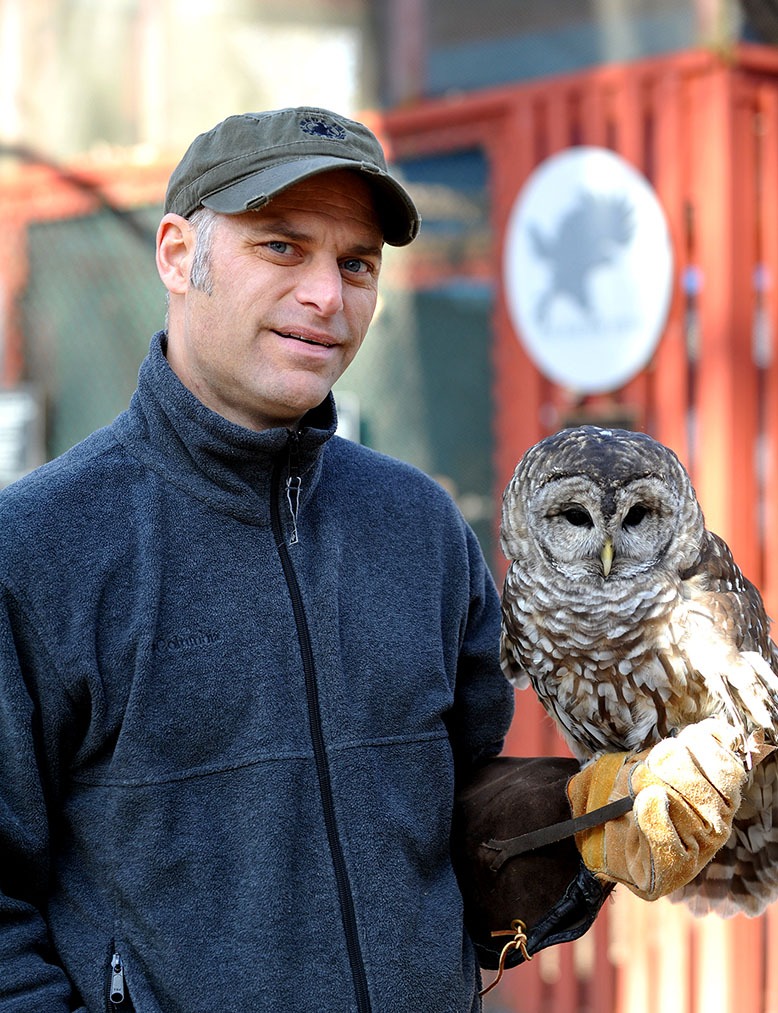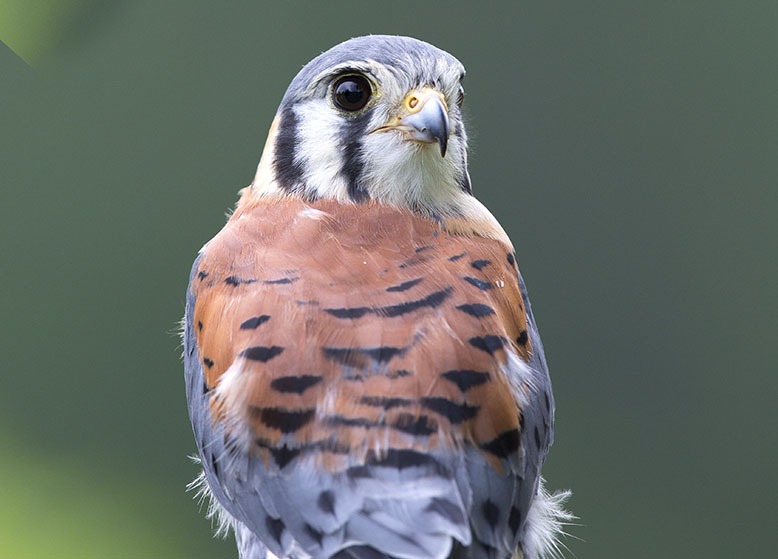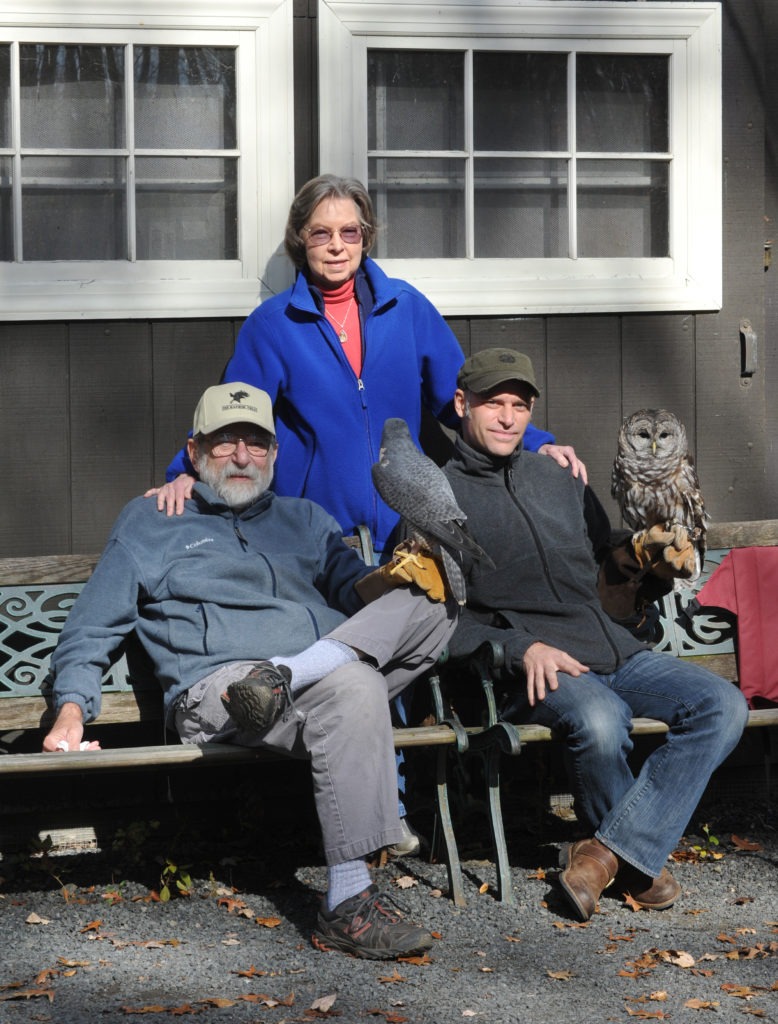
Chris Soucy runs the Raptor Trust in Millington, a family business his late parents founded. “As the legend goes, all this started because my mom asked for a bird feeder in 1951,” he says. Photo courtesy of Becky Bedrosian
On a spring day in 2008, a baby bird fell out of a tree in our backyard. My kids found him on our driveway, chirping pitifully, his leg clearly broken. We gently placed him in a cardboard box lined with a soft towel and tried to think what to do. Our answer came when we searched online for “How to help an injured bird.” And then we were on our way to the Raptor Trust rehabilitation center in Millington, the tiny bird chirping all the way.
Located on White Bridge Road off Route 287 in Morris County, the Raptor Trust was a surprising discovery. Bordering the Great Swamp National Wildlife Refuge, the rustic little oasis in the middle of the woods was 14 acres of green space dotted with small, wood-frame buildings: a bird hospital, a gift shop, and an education center. Set farther back on the property were the aviaries: large, screened structures framed in chunky wood, arranged village-like on curving gravel walkways.
Carefully carrying our cardboard box, we knocked on the door of the infirmary. A kind veterinarian opened the door and ushered us inside. We waited while she examined our little friend, then came out to talk to us. She promised to treat the bird and, if she could, release him back in the wild when he healed. This comforted my children and reassured me that we had done the right thing by bringing him here.
The vet then encouraged us to tour the property before going home, and we did. This proved to be a nearly magical experience. Here were the majestic animals of storybooks and legend: bald eagles, vultures, red-tailed hawks, peregrine falcons. We felt privileged to commune with such beautiful, dignified creatures, especially in such a charming, intimate setting.
When we left the Raptor Trust that day, I marveled that this hidden gem existed so close to New Jersey’s urban and suburban areas. It was just a 40-minute drive from our Montclair home and only 26 miles from Manhattan. I vowed to visit again, and I did—but not until 2022. By then, a lot had changed.
Notably, the founders of the Raptor Trust, Len and Diane Soucy, had passed away, leaving their unique family business to their son, Chris. In a span of five decades, the once quaint backyard hobby of his parents had grown into New Jersey’s preeminent wild-bird rehabilitation center. The property Soucy grew up on had not changed, but the Raptor Trust had expanded to include a fully staffed hospital with an intensive care wing, offering state-of-the-art services like ultrasound, X-rays, ophthalmology and orthopedic repair. Many more aviaries and outbuildings had cropped up as the number of feathered residents increased. But the family’s mission remained the same: to provide free medical care and assistance to injured, sick or orphaned wild birds.

An American kestrel at the Raptor Trust, which cares for more than 6,000 birds annually. Photo courtesy of Ashleigh Scully
Unable to continue to defray the costs themselves, the Trust became a 501(c)(3) nonprofit organization in 1982. Today, more than 6,000 birds a year—50 percent of all injured and orphaned birds in the state—and 25 percent of all wildlife are being cared for by the Raptor Trust. It has been quite a legacy to inherit.
“As the legend goes, all this started because my mom asked for a bird feeder in 1951,” Soucy told me when I visited the premises. (Before starting their organization, Soucy’s father worked as a machinist and his mother worked in a bank.) “Then they got into bird-watching. Then my dad got interested in raptors, and then the birds just started showing up. For a while, we had cardboard boxes all over the house. There were barn owls on the curtain rod in the bathroom, and blue jays and robins in the laundry room.”
Growing up like this, Soucy says, was not necessarily easy, but it was always interesting. He remembered wanting to ride his skateboard on Saturday mornings like other kids, but instead he had to “rake up leftover rodent tails, shovel bird poop and build bird cages.”
“I was my parents’ first volunteer, not really by choice,” he recalls ruefully. “But, you know, I came to appreciate how interesting and valuable that work was. I mean, it was sort of cool to have owls in my backyard, you know? That made me an interesting teen.”
Even so, it was never Soucy’s plan to take over the family business when he grew up. After earning a bachelor’s degree in literature from Rutgers University, he got a master’s in education from Smith College and traveled and worked around the country for years, teaching music to elementary school students.
“I think I always had a sense that someday, I might be called home to roost,” he says, laughing at the pun. “Which is exactly what happened about 10 years ago.”
By then, his parents were advanced in age. His father died not long after he moved back, in 2014. His mother helped him run the business for a few years. Then, in 2020, she died, too. Now the director of the Raptor Trust, Chris honors their memory by carrying on their life’s work.
“I mean, every single day, I feel that legacy,” he says, glancing around the education room, a testimony to the Soucy family’s love of wildlife. The paneled walls are covered in colorful maps, charts, drawings and photographs, with jokes to amuse the children who visit (“Egg-citing facts about birds!”) Real birds’ nests hang on the walls. Lifelike stuffed raptors are perched on shelves, some with wings extended, yellow eyes glinting. It gives the room an active mood, a vibrancy.
“Everything here was built with my father’s two hands,” Soucy notes. “It’s one of the cool things about this place, you know, it’s not a faceless corporation. It’s identity.”

Soucy with his parents, Len and Diane, who passed away in 2014 and 2020, respectively. Photo courtesy of Becky Bedrosian
When asked what it takes to run the Raptor Trust day to day, Soucy considers carefully how to answer, perhaps because his knowledge of wild birds is so deep and granular. He begins with a problem he faces daily: how to feed 6,000 birds a year.
“OK, a lot of the songbirds eat insects,” he begins, “so we buy large numbers of insects at warehouses that supply pet stores. We don’t buy just 10 crickets, we buy 350,000 crickets…. Last year, we bought three-quarters of a million insects.
“The object is to feed our birds whatever comes close to what they get in the wild,” he continues. “Doves, finches and sparrows eat seeds and berries. Some of the birds are omnivores. We buy fish for the bald eagles, herons and other waterbirds. Quails for the peregrine falcons, seeds for the seed eaters, berries for the fruit eaters. We spent $67,000 this year on frozen mice. Our food budget is well into six figures.”
He pauses. “The swans and geese eat grass, so we mow the lawn, put all the grass in a bag, and give it to them. They gobble it up.”
Twenty employees help keep the operation running year-round. Veterinary staff is always on hand to do triage work, as well as the labor-intensive work that bird rescue requires. For example, many sick, injured or baby birds must be fed by hand. About 100 volunteers, student scholars and interns also pitch in.
Another expense is the aviaries themselves. There are upkeep and repair costs, as well as the cost of building new structures. The day I visited, a new aviary was being built. The construction team had framed out the structure, which was roughly the size of a garage. It cost about $35,000, according to Soucy.
As we talked, Soucy took me on a tour of the aviaries. Seeing the birds was just as awe-inspiring as it had been before, only this time, I was given a proper introduction to the inhabitants. Like household pets, each bird has a distinct personality and a few idiosyncrasies, too. There was Pearl, the shy albino robin, and Vilma, the gentle barred owl. Some were in the process of being rehabilitated and would one day return to their natural habitats. Others would live permanently at the Raptor Trust for their own protection.
They all had different reasons for being there. “Some of our birds have wing injuries that didn’t heal properly or an eye injury that prevents them from hunting successfully. That’s a no-go in the wild,” Soucy explains. “A couple of birds are here permanently because they have neurological damage from an impact injury, like if they flew into a window. We also have quite a few birds here that, unfortunately, were just imprinted by humans.”
At this, Soucy shakes his head. “Baby birds are really cute, but people who raise them prevent them from ever becoming birds. They grow up to be people. And they can’t survive in the wild.”
Soucy says protecting wild birds from dangers caused by humans is the most meaningful part of his job. “Remember, if you can walk up to a wild animal and pick it up, there’s already something seriously wrong. But you have to consider the situation. If the bird is a juvenile and it’s not obviously injured, it’s often best not to intervene. If there are no cats nearby, the bird’s parents will usually come back to feed it,” he says. “Of course, if a bird is obviously injured, or you find a large, possibly dangerous bird, such as a raptor, call us.”
Wild birds often suffer because of human encroachment on their habitats, negligence, or both. It is common for people to try to solve a problem or remedy an inconvenience in nature and never realize how much their actions impact wildlife.
“We have many conversations about invasive and non-native species such as the spotted lanternfly,” an insect causing damage to trees and plants in New Jersey, Soucy says. “I know it’s a danger to agriculture, but people put sticky tape around trees, and then birds get caught in the tape. We saw about 100 birds this year with their feathers ripped off from that tape. Some of them broke their own bones trying to free themselves. The survival rate for them was very low.”
Soucy also cautions people against leaving fishing wire, sports nets or plastic bags outside.
From Soucy’s perspective, protecting birds is not only his life’s work, but part of a larger effort to protect wildlife and the environment.
“For us, birds are our little niche, so at the micro level, we deal with individual stories,” says Soucy.
“But at the macro level, when we release a bald eagle or peregrine falcon, we have to consider where those endangered species will be in New Jersey in the future.”
Leaving the Raptor Trust that day, I felt reassured, just as I did on that day long ago, when I knew our little foundling was in good hands. But this time, I felt a greater gratitude for the big work this small organization was doing.
“Growing up, I always understood that the work my parents were doing was not just repairing injuries. It was educating people,” Soucy told me at the conclusion of our interview. “Part of our mission was providing a humane example for how to be better stewards of our environment. That was pretty easy to grasp, even for a kid.”
The Raptor Trust is supported by grants and donations. It is open for free, self-guided tours of the aviary trail seven days a week from 9 am–4 pm. If you find an injured bird, call 908-647-2353 for an appointment.
Linda Federico-ÓMurchú is an award-winning journalist whose work has appeared on NBC News, Today, CNBC and in other publications. She is the author of two books in progress.
No one knows New Jersey like we do. Sign up for one of our free newsletters here. Want a print magazine mailed to you? Purchase an issue from our online store.
